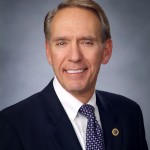Chancellor Reflects on Leadership Role
By Sonya Stinson
November 3, 2015
A Q&A with Brice Harris, the chancellor of the California Community Colleges system, who plans to retire in the spring.
 Brice Harris wants to “spend some time being a granddad.” That’s what he plans to do when he steps down in April, after three years as chancellor of the nation’s largest community college system. But although Harris will have a bit more time on his hands once he’s no longer in charge of the California Community Colleges system, he plans to stay involved in its mission.
Brice Harris wants to “spend some time being a granddad.” That’s what he plans to do when he steps down in April, after three years as chancellor of the nation’s largest community college system. But although Harris will have a bit more time on his hands once he’s no longer in charge of the California Community Colleges system, he plans to stay involved in its mission.
“I do intend to continue to keep my toe in the water of community college education in California and, frankly, across the country,” Harris said. “I’m very interested in the intersection between young CEOs and boards, so I hope to do some work in that regard — perhaps some advising to young CEOs and boards, and maybe even some writing on that subject in the future.”
During our interview, Harris talked about some of his proudest achievements as chancellor and how he hopes the momentum will continue after he leaves his post.
What were the biggest challenges the California Community Colleges system was facing when you took over as chancellor, in 2012?
I started on Election Day in November 2012, and it was in that election that the voters were considering Proposition 30, which was a tax increase here in California. I signed on for the post without knowing whether that thing was going to pass, and we were in the middle of the worst five years that I think any of us has ever experienced financially. We had rationed education. We had seen a half a million Californians denied access to our colleges. So the greatest challenge was restoring that access and, at the same time, improving student success.
Thankfully, on that day I took the job, the voters agreed to pass Proposition 30, and the finances of California colleges began improving almost immediately.
What accomplishments do you count among the most rewarding of your tenure?
Let me underscore this: I happen to be the fortunate guy sitting in this office. The accomplishments that have taken place over the last three years are really due to the hard work and dedication of a great Board of Governors at the state level and a team of vice chancellors here in the chancellor’s office — and the staff here — as well as an immensely cooperative field.
But there are two or three things that I think the system can be really proud of. The first of those certainly is the completion in the chancellor’s office of the work on the 22 recommendations [from the Board of Governor’s Student Success Task Force] for student success. The second is the beginning of the restoration of access to the system. We finally have seen enrollment bottom out and begin to climb again.
A couple of other things I can be really proud of are the agreement with the legislature for the pilot bachelor’s degrees at 15 of our colleges that are now under development, and the dramatically improved relationship with the California State University, in terms of transfer. More than 1,900 transfer degrees have been created in our system over the last three years.
What’s the most important thing you’ve learned in leadership during these last three years that you didn’t know when you started the job?
Focus. When I took the job, it was pretty quickly clear to me that the restoration of access and the improvement of success were going to be the most important things that we were going to work on. However, in a system of this size, with now 113 colleges and more than 2 million students, there are a myriad of constituent groups and think tanks and elected officials and well-minded people who have a variety of things they think you should be doing.
Everything we do has been aimed at opening the doors of these colleges back up and helping students succeed and grow their numbers. To me, the greatest surprise I had was that, with the enormity of this system, it was really my job as the leader to keep the system focused on those two things.
As you step down, how would you like to see the California Community Colleges system build on its successes in the years to come?
I really do believe that the system is extremely well positioned to restore the access that I think most of us believe the system should have. I believe there is likely to be approaching 3 million students in this system by 2025.
The other thing I think this system will do is enhance student success — not only directly as it relates to the students who are in our institutions now but [also with] the improvement of transfer, [with] the success of this bachelor’s pilot and ultimately the expansion of those degrees.
The system just finished a month-long look at career-tech education. I look for the board to approve those recommendations in November, and the system will spend the next couple of years implementing those, really enhancing career education and workforce development in California.










